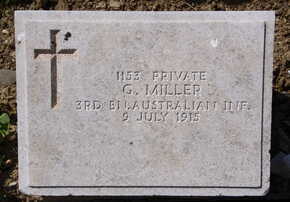
MILLER, George
| Service Number: | 1153 |
|---|---|
| Enlisted: | 1 September 1914, Enlisted at Sydney |
| Last Rank: | Private |
| Last Unit: | 3rd Infantry Battalion |
| Born: | Lockhart's Creek, Victoria, Australia, 1890 |
| Home Town: | Tallangatta, Towong, Victoria |
| Schooling: | Not yet discovered |
| Occupation: | Miner |
| Died: | Killed in action, Gallipoli, Turkey, 10 July 1915 |
| Cemetery: |
Shrapnel Valley Cemetery, Gallipoli Plot 1, Row A, Grave 19. |
| Memorials: | Australian War Memorial Roll of Honour |
World War 1 Service
| 1 Sep 1914: | Enlisted AIF WW1, Private, 1153, Enlisted at Sydney | |
|---|---|---|
| 20 Oct 1914: | Involvement Private, 1153, 3rd Infantry Battalion, ANZAC / Gallipoli, --- :embarkation_roll: roll_number: '7' embarkation_place: Sydney embarkation_ship: HMAT Euripides embarkation_ship_number: A14 public_note: '' | |
| 20 Oct 1914: | Embarked Private, 1153, 3rd Infantry Battalion, HMAT Euripides, Sydney |
Help us honour George Miller's service by contributing information, stories, and images so that they can be preserved for future generations.
Add my storyBiography contributed by Carol Foster
Son of Thomas and Julia Ann Miller of Wodonga, Victoria; brother of Robert Miller who returned to Australia on 23 July 1918 having served with the 57th Battalion, William Miller who was killed in action on 30 July 1918 while serving with the 8th Battalion and Earnest Millier who returned to Australia on 25 January 1919 having served with the 3rd Battalion
Medals: 1914-15 Star, British War Medal, Victory Medal
Biography contributed by Stephen Brooks
George Miller was one of four sons of Thomas and Julia Ann Miller who served in the AIF. He was born at Lockhart’s Creek, near Tallangatta in Victoria. The father, Thomas, had left the family in around 1900 so the children were raised by their mother.
George was mentioned in Melbourne Argus in early 1915, under the heading “Determined to Serve.”
“George Miller, of Tallangatta, is determined to reach the front. He gave up employment and volunteered for service. At the Melbourne barracks he was rejected owing to slight evidence of physical trouble. As he had no friends, he had to sleep out in Melbourne all night. He had journeyed to Wodonga on a railway pass next day, and slept in the Wodonga station that night and arrived here the next afternoon. He was five days without food. After blacksmithing for a few days for funds, he worked his way in a sheep special to Albury, in order to undergo a minor operation at the hospital prior to his going to Melbourne again for re-examination. "I am going to the front some way or another," he says.”
He was eventually accepted in Sydney, on 1 September 1914, into the 3rd Battalion and was still among the first Australians to be accepted.
George Miller took part in the landing at Anzac on 25 April 1915, and he survived until 9 July 1915 when he was reported as killed in action.
Much later in the war, during 1918 it was reported in the Upper Murray and Mitta Herald that “in connection with the death of Private George Miller, sixth son of Mrs. Julia Miller, of Lockhart's Creek, Mrs. Miller has received the following letter from Lieut. R. Ingram Moore, dated Gallipoli, 11/7/15:
Poor Miller, one of my old tent-mates. You will see him standing in the photo I sent you. He was knocked out the other day. I would not mention this to you but for the peculiar feeling that came over me. Never have I felt the desire to kill as I have since "Blue" Miller passed away. Perhaps it is because he was such a fine stamp of man, and also having dwelt in the same tent for such a long while. He joined almost the same day as I did. Even during those first four days I did not ‘see red,’ but it has made my, blood boil to see such a man killed, and the one consoling thought is that he died as he had lived - a hero.
This is not exaggerated hero-worship on my part. If you could have seen him when we landed, you would understand how I feel. At that time, he was supplying ammunition to our two machine-guns. Several times I saw him running with a full box of ammunition, from one machine to the other under the enemy's machine-gun and rifle fire, with the bullets cutting-up the ground around him and even under his feet as he ran. Still, he never hesitated. If ever a man won a V.C., he did; but, not being noticed by one of the heads, he did not get it. However, all his mates knew him for a brave man, which amounts to same thing. (Lieutenant R. Ingram Moore was subsequently made Captain and was decorated by King George, but he was killed in 1917.)”
This was high praise as the then Corporal Ralph Ingram Moore had won an extremely rare Gallipoli Distinguished Conduct Medal for great gallantry during the Anzac Landing from 25-29 April 1915. He went on to be awarded a Military Cross and several Mentions in Despatches.










